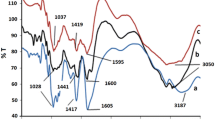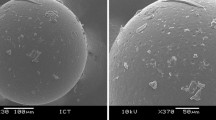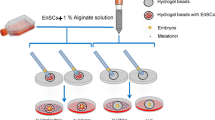Abstract
Objective: To prepare microencapsulated cells releasing human tissue inhibitor of metalloproteinase-2 (TIMP-2), and investigate their biological characteristics in vitro. Methods: Chinese hamster ovary (CHO) cells were stably transfected with a human TIMP-2 expression vector, encapsulated in barium alginate microcapsules and cultured in vitro. Morphological appearance of the microcapsules was observed under a light microscope. Cell viability was assessed using MTT (3-(4,5-dimethylthiazol-2-yl)-2,5-diphenyltetrazolium bromide) assay. Enzyme linked immunosorbent assay (ELISA) and reverse zymography were used to confirm the release of biologically active TIMP-2 from the microcapsules. Cryopreservation study of the microencapsulated cells was carried out using dimethyl sulfoxide (DMSO) as preservative agent. Results: The microcapsules appeared like a sphere with diameter of 300–600 μm. The surface of the capsule wall was clearly smooth. The microencapsulated cells survived well and kept proliferating over the 6 weeks observed. No significant difference in TIMP-2 secretion was found between encapsulated and unencapsulated cells. Reverse zymography confirmed the bioactivity of MMP (matrix metalloproteinase) inhibition of TIMP-2. The cryopreservation process did not damage the microcapsule morphology nor the viability of the cells inside. Conclusion: Microencapsulated engineered CHO cells survive at least 6 weeks after preparation in vitro, and secrete bioactive TIMP-2 freely from the microcapsules.
Similar content being viewed by others
References
Brand, K., Baker, A.H., Perez-Canto, A., Possling, A., Sacharjat, M., Geheeb, M., Arnold, W., 2000. Treatment of colorectal liver metastases by adenoviral transfer of tissue inhibitor of metalloproteinases-2 into the liver tissue.Cancer Res.,60:5723–5730.
Chang, P.L., van Raamsdonk, J.M., Hortelano, G., Barsoum, S.C., MacDonald, N.C., Stockley, T.L., 1999. The in vivo delivery of heterologous proteins by microencapsulated recombinant cells.Trends Biotechnol.,17:78–83.
Cirone, P., Bourgeois, J.M., Chang, P.L., 2003. Antiangiogenic cancer therapy with microencapsulated cells.Hum. Gene Ther.,14:1065–1077.
Hojilla, C.V., Mohammed, F.F., Khokha, R., 2003. Matrix metalloproteinases and their tissue inhibitors direct cell fate during cancer development.Br. J. Cancer,89:1817–1821.
Imren, S., Kohn, D.B., Shimada, H., Blavier, L., DeClerck, Y.A., 1996. Overexpression of tissue inhibitor of metalloproteinases-2 by retroviral-mediated gene transfer in vivo inhibits tumor growth and invasion.Cancer Res.,56:2891–2895.
Joki, T., Machluf, M., Atala, A., Zhu, J., Seyfried, N.T., Dunn, I.F., Abe, T., Carroll, R.S., Black, P.M., 2001. Continuous release of endostatin from microencapsulated engineered cells for tumor therapy.Nat. Biotechnol.,19:35–39.
Li, H., Lindenmeyer, F., Grenet, C., Opolon, P., Menashi, S., Soria, C., Yeh, P., Perricaudet, M., Lu, H., 2001. Ad-TIMP-2 inhibits tumor growth, angiogenesis, and metastasis, and prolongs survival in mice.Hum. Gene Ther.,12:515–526.
Lim, F., Sun, A.M., 1980. Microencapsulated islets as bioartificial edocrine pancreas.Science,210:908–910.
Montgomery, A.M., Mueller, B.M., Reisfeld, R.A., Taylor, S.M., DeClerck, Y.A., 1994. Effect of tissue inhibitor of the matrix metalloproteinases-2 expression on the growth and spontaneous metastasis of a human melanoma cell line.Cancer Res.,54:5467–5473.
Omer, A., Duvivier-Kali, V.F., Trivedi, N., Wilmot, K., Bonner-Weir, S., Weir, G.C., 2003. Survival and maturation of microencapsulated porcine neonatal pancreatic cell clusters transplanted into immunocompetent diabetic mice.Diabetes,52:69–75.
Orive, G., Hernandez, R.M., Gascon, A.R., Calafiore, R., Chang, T.M., de Vos, P., Hortelano, G., Hunkeler, D., Lacik, I., Shapiro, A.M., Pedraz, J.L., 2003. Cell encapsulation: Promise and progress.Nat. Med.,9:104–107.
Orive, G., Hernandez, R.M., Gascon, A.R., Calafiore, R., Chang, T.M., de Vos, P., Hortelano, G., Hunkeler, D., Lacik, I., Pedraz, J.L., 2004. History, challenges and perspectives of cell microencapsulation.Trends Biotechnol.,22:87–92.
Read, T.A., Sorensen, D.R., Mahesparan, R., Enger, P.O., Timpl, R., Olsen, B.R., Hjelstuen, M.H., Haraldseth, O., Bjerkvig, R., 2001. Local endostatin treatment of gliomas administered by microencapsulated producer cells.Nat. Biotechnol.,19:29–34.
Stetler-Stevenson, W.G., 1999. Matrix metalloproteinases in angiogenesis: A moving target for therapeutic intervention.J. Clin. Invest.,103:1237–1241.
Tai, I.T., Sun, A.M., 1993. Microencapsulation of recombinant cells: A new delivery system for gene therapy.FASEB J.,7:1061–1069.
Uludag, H., de Vos, P., Tresco, P.A., 2000. Technology of mammalian cell encapsulation.Adv. Drug Deliv. Rev.,42:29–64.
Valente, P., Fassina, G., Melchiori, A., Masiello, L., Cilli, M., Vacca, A., Onisto, M., Santi, L., Stetler-Stevenson, W.G., Albini, A., 1998. TIMP-2 over-expression reduces invasion and angiogenesis and protects B16F10 melanoma cells from apoptosis.Int. J. Cancer.,75:246–253.
Vincent, L., Varet, J., Pille, J.Y., Bompais, H., Opolon, P., Maksimenko, A., Malvy, C., Mirshahi, M., Lu, H., Vannier, J.P., Soria, C., Li, H., 2003. Efficacy of dendrimer-mediated angiostatin and TIMP-2 gene delivery on inhibition of tumor growth and angiogenesis: In vitro and in vivo studies.Int. J. Cancer,105:419–429.
Xu, W., Liu, L., Charles, I.G., 2001. Microencapsulated iNOS-expressing cells cause tumor suppression in mice.FASEB J.,16:213–215.
Author information
Authors and Affiliations
Corresponding author
Rights and permissions
About this article
Cite this article
Qiang, J., Su-zhan, Z., Jia-ping, P. et al. Preparation and in vitro studies of microencapsulated cells releasing human tissue inhibitor of metalloproteinase-2. J. Zheijang Univ.-Sci. B 6, 859–864 (2005). https://doi.org/10.1007/BF02840993
Received:
Accepted:
Issue Date:
DOI: https://doi.org/10.1007/BF02840993




